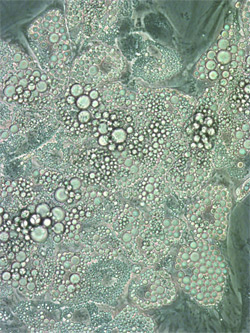fitness news
![]() ,
,![]()
Font size Weight Management
Increasing fat burning by reprogramming fat cells
– Reported December 19, 2014

White adipose tissue stores excess calories as fat that can be released for use in other organs during fasting. Mammals also have small amounts of brown adipose tissue, which primarily acts as an effective fat burner for the production of heat. Now researchers from the University of Southern Denmark have uncovered the mechanism by which white fat cells from humans gets reprogrammed to become browner.
Browning of white adipose tissue increases the energy consumption of the body and therefore constitutes a potential strategy for future treatment of obesity. The challenge is to reprogram the energy storing white fat cells into so-called “brite” (brown-in-white) fat cells in the body’s white adipose tissue and thus make adipose tissue burn off excess energy as heat instead of storing it.
The research team from the Department of Biochemistry and Molecular Biology headed by Professor Susanne Mandrup are publishing a paper entitled “Browning of human adipocytes requires KLF11 and reprogramming of PPAR super-enhancers” in the January 1 edition of the scientific journal “Genes & Development” that describes their results from working with “brite” fat cells.
“We have investigated how the genome of white adipocytes is reprogrammed during browning using advanced genome sequencing technologies. We stimulated browning in human white adipocytes by a drug used to treat type II diabetes and compared white and “brite” fat cells. This showed that “brite” fat cells have distinct gene programs which, when active, make these cells particularly energy-consuming,” says Susanne Mandrup and continues.
“By identifying the areas of the genome that are directly involved in the reprogramming, we have also identified an important factor in the process – the gene regulatory protein KLF11 (Kruppel Like Factor-11), which is found in all fat cells, and we have shown that it is required for the reprogramming to take place.”
One of the absolute main forces behind the project and first author of the paper is PhD student Anne Loft, who is very pleased with the results.
“It has been a long process, and it has taken us four years to get where we are now, so it’s obviously very satisfying when the results are so interesting and useful, as is the case here,” says Anne Loft and points to the future prospects of the research on “brite” fat cells.
“The discovery of the “brite” fat cell mechanisms and the specific regulatory areas brings us closer to understanding how reprogramming of white fat cells takes place. This knowledge potentially means, that in the future we can target drugs to activate the genomic regions and browning factors like KLF11 in the treatment of obesity,” says Anne Loft.
source: http://www.medicalnewstoday.com